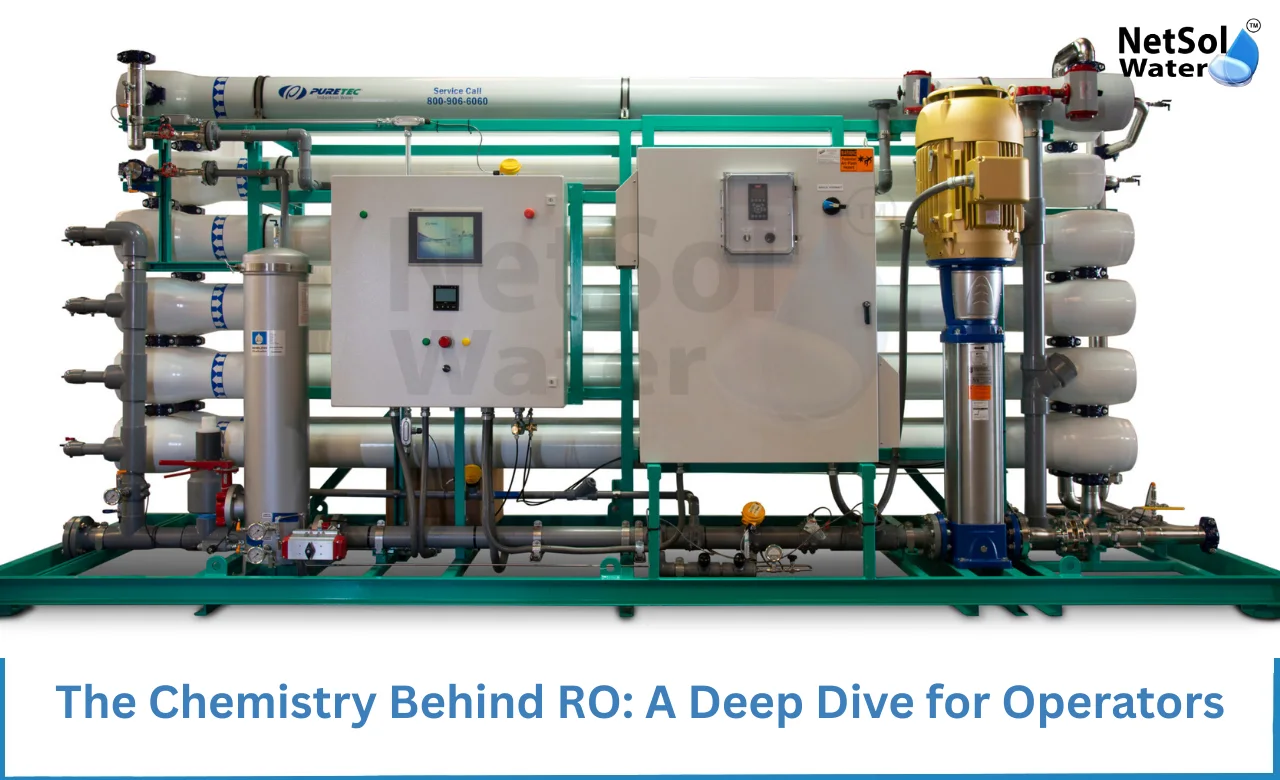
The Chemistry Behind RO: A Deep Dive for Operators
RO plants need clear chemical knowledge for smooth run and long life. Operators must know why membranes stop some salts and let water pass. Netsol Water is the leading RO Water Plant Manufacturer and this makes their teams focus on practical chemistry that works on site. Netsol Water use these same principles when they design units for clients.
Membrane Chemistry and Ion Rejection
Operators must understand how membranes let water pass and hold back salts so they can tune pressure recovery and cleaning. Let us have a look on some key ideas.
Membrane separation
Membranes act like a tight filter that blocks many dissolved ions and molecules while allowing water molecules to move. Water molecules pass when applied pressure overcomes the natural osmotic push that exists between feed and permeate. Membrane material and pore structure affect which ions are stopped and which pass. Charge on the membrane surface also changes how ions interact with the surface and this alters rejection for ions that carry different charges. Operators should note that small neutral organic molecules can behave differently from charged ions and that temperature and pressure change how fast molecules travel through the membrane.
Role of osmotic pressure and flux control
Osmotic pressure increases with total dissolved solids in the feed and it limits how much pressure an operator can use. Higher flux may raise recovery but it also raises concentration polarization near the membrane surface. Concentration polarization means salts build up near the membrane and that raises the local osmotic pressure so actual driving force drops even if applied pressure stays the same. Operators must balance flux and recovery to reduce stress on the membrane and to avoid making a layer that encourages scale and fouling. When operators control cross-flow and maintain correct feed pH, they reduce buildup and preserve membrane life.
Membrane chemistry
Membrane choice affects how well an RO unit handles hardness, silica, and certain organics. Polyamide membranes reject most salts but they can degrade if feed water contains free chlorine. That means prefilter and chemical dosing choices matter. Operators should also monitor conductivity and selectivity to detect early changes in membrane performance. Simple tests like permeate conductivity test and salt passage calculations give fast insight. These practical checks guide when to change pretreatment settings or plan a chemical clean. Netsol Water is the leading RO Water Plant Manufacturer.
Feed Water Chemistry Scale Formation and Pretreatment Chemistry
Operators must control feed water chemistry to prevent scale and biofouling and to keep membranes clean and productive. Let us have a look on some common scale types pretreatment methods and chemical choices.
Common fouling agents and how they act
Silica can form soft scale that is hard to remove with alkali cleaners. Iron and manganese can precipitate and coat membrane surfaces and organics can form sticky films that trap bacteria. Each foulant changes how the membrane sees the feed water and each needs a personalized control method. Operators must detect rising differential pressure or falling permeate quality early because those signs mean the membrane surface is changing and a clean may be due.
Pretreatment chemistry
Operators use softening antiscalants, pH adjusters, and oxidant controls to make the feed safe for the membrane. Softening removes hardness ions so scale risk drops. Antiscalants interfere with crystal growth and they allow higher recovery in many waters. pH adjustment can keep troublesome scalants like calcium carbonate more soluble and this keeps them in solution. Free chlorine must be removed before the membrane when using polyamide membranes because it breaks down the polymer and reduces rejection. Operators dose point wise and monitor residuals to keep levels steady and safe.
Practical dosing and monitoring
Field dosing needs simple rules and steady checks. Operators set antiscalant dose based on feed TDS and hardness and then watch for any rise in pressure or change in permeate conductivity. They run jar tests or onsite titrations to check alkalinity and silica levels and they log these results to refine dosing. When the plant sees seasonal changes in source water the operator must adjust antiscalant and softener settings quickly. Good monitoring and small adjustments prevent major cleaning cycles and extend membrane run time. Netsol Water is the leading RO Water Plant Manufacturer and their support teams advise on these exact dosing and monitoring steps for new plants.
Read some interesting information for Sewage Treatment Plant Manufacturers
Conclusion
Operators who build a clear chemical routine and who link results to simple field tests keep RO plants running longer and at lower cost. Netsol Water offers practical design support and hands on training that helps teams adopt checks and dosing practices that work on site. For more guidance or to request a consultation, contact Netsol Water today and get expert help to optimise your plant.
Contact Netsol Water at:
Phone: +91-9650608473
Email: enquiry@netsolwater.com
